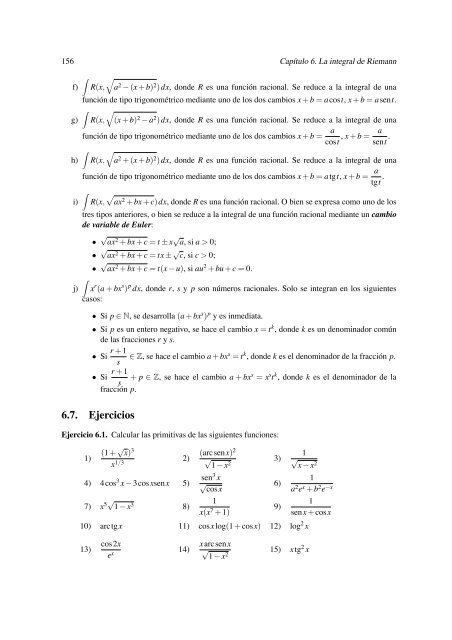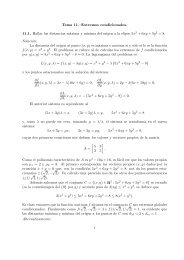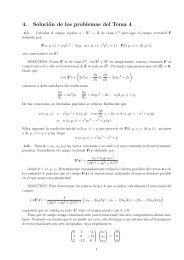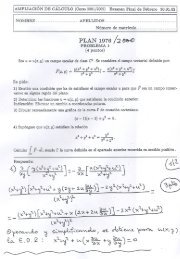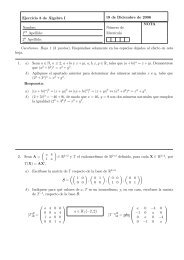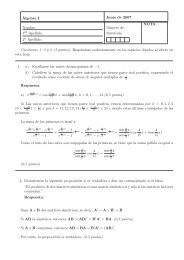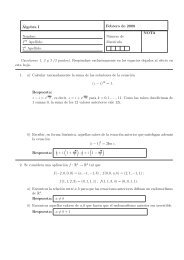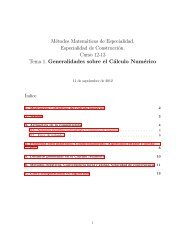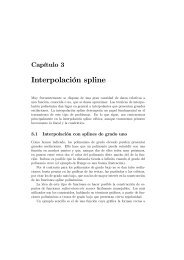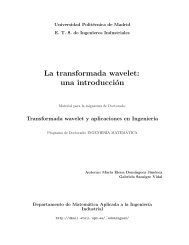La integral de Riemann - dmaii
La integral de Riemann - dmaii
La integral de Riemann - dmaii
Create successful ePaper yourself
Turn your PDF publications into a flip-book with our unique Google optimized e-Paper software.
156 Capítulo 6. <strong>La</strong> <strong>integral</strong> <strong>de</strong> <strong>Riemann</strong><br />
f)<br />
<br />
<br />
R(x, a2 − (x + b) 2 )dx, don<strong>de</strong> R es una función racional. Se reduce a la <strong>integral</strong> <strong>de</strong> una<br />
función <strong>de</strong> tipo trigonométrico mediante uno <strong>de</strong> los dos cambios x + b = acost, x + b = asent.<br />
<br />
g) R(x, (x + b) 2 − a2 )dx, don<strong>de</strong> R es una función racional. Se reduce a la <strong>integral</strong> <strong>de</strong> una<br />
función <strong>de</strong> tipo trigonométrico mediante uno <strong>de</strong> los dos cambios x + b = a<br />
a<br />
, x + b =<br />
cost sent .<br />
<br />
h) R(x, a2 + (x + b) 2 )dx, don<strong>de</strong> R es una función racional. Se reduce a la <strong>integral</strong> <strong>de</strong> una<br />
función <strong>de</strong> tipo trigonométrico mediante uno <strong>de</strong> los dos cambios x + b = atgt, x + b = a<br />
tgt .<br />
i)<br />
<br />
R(x, ax2 + bx + c)dx, don<strong>de</strong> R es una función racional. O bien se expresa como uno <strong>de</strong> los<br />
tres tipos anteriores, o bien se reduce a la <strong>integral</strong> <strong>de</strong> una función racional mediante un cambio<br />
<strong>de</strong> variable <strong>de</strong> Euler:<br />
• √ ax 2 + bx + c = t ± x √ a, si a > 0;<br />
• √ ax 2 + bx + c = tx ± √ c, si c > 0;<br />
• √ ax2 + bx + c = t(x − u), si au2 + bu + c = 0.<br />
<br />
j) x r (a + bx s ) p dx, don<strong>de</strong> r, s y p son números racionales. Solo se integran en los siguientes<br />
casos:<br />
• Si p ∈ N, se <strong>de</strong>sarrolla (a + bx s ) p y es inmediata.<br />
• Si p es un entero negativo, se hace el cambio x = tk , don<strong>de</strong> k es un <strong>de</strong>nominador común<br />
<strong>de</strong> las fracciones r y s.<br />
r + 1<br />
• Si<br />
s ∈ Z, se hace el cambio a + bxs = tk , don<strong>de</strong> k es el <strong>de</strong>nominador <strong>de</strong> la fracción p.<br />
r + 1<br />
• Si<br />
s + p ∈ Z, se hace el cambio a + bxs = xstk , don<strong>de</strong> k es el <strong>de</strong>nominador <strong>de</strong> la<br />
fracción p.<br />
6.7. Ejercicios<br />
Ejercicio 6.1. Calcular las primitivas <strong>de</strong> las siguientes funciones:<br />
1)<br />
(1 + √ x) 3<br />
x 1/3<br />
2)<br />
4) 4cos 3 x − 3cosxsenx 5)<br />
7) x 5√ 1 − x 3 8)<br />
(arcsenx) 2<br />
√ 1 − x 2<br />
sen3 x<br />
√<br />
cosx<br />
1<br />
x(x7 + 1)<br />
3)<br />
6)<br />
1<br />
√ x − x 2<br />
10) arctgx 11) cosxlog(1 + cosx) 12) log 2 x<br />
13)<br />
cos2x<br />
e x<br />
14)<br />
xarcsenx<br />
√ 1 − x 2<br />
9)<br />
1<br />
a 2 e x + b 2 e −x<br />
1<br />
senx + cosx<br />
15) xtg 2 x


